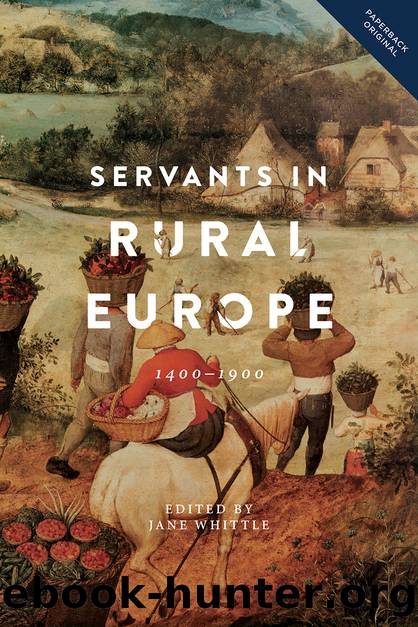Servants in Rural Europe by Whittle Jane.;Economic History Society.;

Author:Whittle, Jane.;Economic History Society.; [Whittle, Jane.;Economic History Society.;]
Language: eng
Format: epub
ISBN: 9781787441316
Publisher: Boydell & Brewer
7
Rural Servants in Eighteenth-Century Münsterland, North-Western Germany: Households, Families and Servants in the Countryside
CHRISTINE FERTIG
Servants have attracted relatively little attention in German rural history. This neglect is quite striking, since in many parts of Germany peasant farms passed on undivided, and fluctuations in the workforce provided by family members were balanced by additional workers. From the perspective of the peasant household, servants helped to bridge family phases with either a high burden of small children or after adult children had left the paternal home.1 The employment of servants, or alternatively day labourers, depended on regional practices and ecotypes, such as the prevalence of animal husbandry, grain cultivation or other forms of agriculture. Agricultural modernization in the late eighteenth and early nineteenth centuries was to a large degree driven by increasing labour input, but in general there has been little research on rural labour markets.2 J. Schlumbohm has shown that many landless families were affiliated to peasant farms as âHeuerlingeâ, renting rooms or small houses from peasants, often with the obligation to work on demand. In return, peasants made their farming equipment available, and supported their lodgers in times of crises. His analysis of a series of contracts between peasants and lodgers revealed the highly individual relationships between peasantsâ and day labourersâ households.3 If arrangements and relations between peasants and day labourers are one open research issue in German rural history, the relationship between peasants and servants is another. After discussing the current state of scholarship on servants, this chapter analyses a set of census lists, gathered on the instruction of the prince-bishop of Münster, for Münsterland in 1749/50. This source has been little used for academic research, although parts have been incorporated into a larger research project on European census lists.4 With the exception of one detailed village study discussing many aspects of historical life and economy, it has not previously been used to investigate servants.5
Legal relationships between servants and their masters have attracted the attention of historians for a long time. The concept of the âGanze Hausâ, put forward by Otto Brunner in 1968, provoked research but also severe criticism by historians of early modern Germany. The basic idea of paternalistic and attentive togetherness within premodern households was criticized as a modern romanticizing of unequal and authoritarian relationships.6 The particular attention on the normative basis of the peasant-servant relationship can perhaps be traced back to the overwhelming quantities of âGesindeordnungenâ (decrees on servants). In Prussia alone, authorities passed fifty-two decrees between 1595 and 1799, or roughly one new decree every four years. Even if these affected different regions of the Prussian territory, this number demonstrates the ready availability of sources about normative regulations as well as the probable futility of the repeated attempts by the authorities to regulate service. These decrees regulated many aspects of service such as how a valid contract should be made, the obligations of servants, their (very limited) rights to terminate contracts, mastersâ rights to punish servants, wage levels, and board and lodging. But there
Download
This site does not store any files on its server. We only index and link to content provided by other sites. Please contact the content providers to delete copyright contents if any and email us, we'll remove relevant links or contents immediately.
Women and Jewish Marriage Negotiations in Early Modern Italy by Howard Tzvi Adelman(367)
Warrior King by Wilbur Smith(290)
18 real-life stories of serial killers and murderers with solved and unsolved killings from the USA, UK, Europe, and beyond. by Ben Oakley(242)
Who's Who in the Zulu War, 1879: The British by Adrian Greaves Ian Knight(240)
Violence and Emotions in Early Modern Europe by Susan Broomhall;Sarah Finn;(224)
The American Crisis by Unknown(218)
The Battle of Austerlitz by 50minutes(209)
The Seeker by S. G. MacLean(196)
The Dutch East India Company and British East India Company: The History and Legacy of the Worldâs Most Famous Colonial Trade Companies by Charles River Editors(191)
The Origins of French Absolutism, 1598-1661 by Alan James(184)
The Traitor of Colditz by Robert Verkaik(174)
Fires of Faith by Catholic England under Mary Tudor(172)
A Genius for Confusion by Richard M. Fried(169)
Invisible Worlds by Peter Marshall(169)
The Opium Wars: Exploring the Addiction of Empires from Beginning to End by Ramos Adrian & Compacted History(168)
Interest and Connection in the Eighteenth Century by Jacob Sider Jost(167)
The Slave Trade in Africa by Simon Webb;(166)
Islam and the Trajectory of Globalization by Louay M. Safi(163)
The Thirty Years War â Complete by Friedrich Schiller(161)
